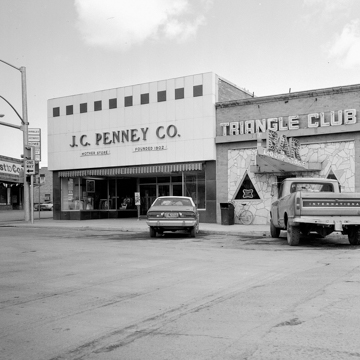Today J.C. Penney is a household name, with over 1,000 stores worldwide. The company is known for its department store brand, selling clothing, jewelry, and housewares. It is named for James Cash Penney, who opened his first store in Kemmerer, Wyoming, in 1902.
Penney was born in 1875 in Hamilton, Missouri, to a struggling farm family. If their son’s middle name is any indication, they were hopeful of a more prosperous life in the future. By the age of 8, James was told he was financially responsible for his own clothing, thus giving him an incentive to earn money at a young age. After graduating from high school, Penney was hired as a store clerk, and was promoted several times before he was diagnosed with tuberculosis and instructed to seek clear skies and fresh air in the West.
After first settling in Colorado, Penney eventually found work as a store clerk at the Golden Rule Store in Evanston, Wyoming, a dry goods and clothing store owned by Thomas M. Callahan and W. Guy Johnson. Callahan owned a number of these Golden Rule Stores in the Midwest and Rocky Mountain states, and was anxious to open more. He and Johnson offered Penney a one-third partnership in a new store, and Penney pushed for the store to open in a small town with fewer competitors and lower overhead costs; in 1902, they settled on Kemmerer. This store, which has had three locations in Kemmerer, became known as the “Mother Store” of the J.C. Penney Company. The original 1902 store (no longer extant) was a frame building with a second floor where Penney and his wife resided. It was soon outgrown, however, and in 1904 the store moved to a larger stone building on Main Street.
By 1907, Penney was able to buy out Callahan and Johnson. He then opened two additional stores in Rock Springs and Cumberland (a now deserted coal-mining town 17 miles south of Kemmerer). By 1909 the Kemmerer store was so successful that Penney left it in the hands of a trusted manager with the vision of continuing his chain in other states. He moved his family to Salt Lake City, Utah, and opened 28 new stores throughout the west over the next three years. In 1913, Penney incorporated the chain of department stores as “J.C. Penney,” and moved his family and corporate headquarters to New York City.
In Kemmerer today, there are three buildings that represent the early history of the J.C. Penney empire—the family residence, the building that housed the store from 1904 to 1935, and the circa 1921 building where the store moved in 1935. The latter is now known as the J.C. Penney Mother Store and still operates today.
When J.C. Penney died in 1975, he left behind an empire. His vision for all-cash sales, quickly turning over inventory, and opening stores where they were needed most meant great success. The importance of the J.C. Penney legacy in Kemmerer was recognized when the J.C. Penney Historic District, comprising Penney’s house, the Golden Rule Store, and two adjoining commercial buildings, was listed as a National Historic Landmark in 1978.
References
Christian, Ralph J., “J.C. Penney Historic District,” Lincoln County, Wyoming. National Register of Historic Places Inventory–Nomination Form, 1977. National Park Service, U.S. Department of the Interior, Washington, D.C.
Curry, Mary Elizabeth. “J.C. Penney.” American National Biography. Vol. 17. New York: Oxford University Press, 1997.

